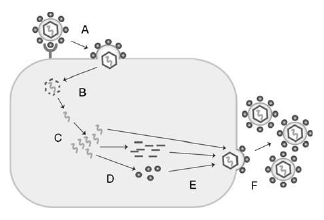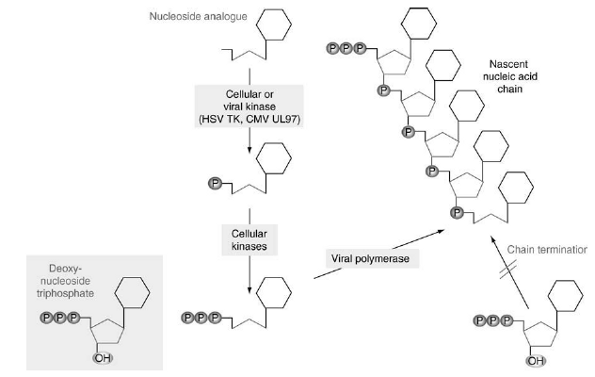Viral infections are caused by viruses – tiny intracellular parasites. The central part of the virus particle consists of a nucleic acid outer membrane of protein. The main material is infectious viral nucleic acid (RNA or DNA) which penetrates into susceptible cells.
Viruses are not capable of self-division. The reproduction of viruses is possible only in the infected host cell (bacterial, plant or animal). Outside the cell they are inert.
Viral infections affecting humans are spread mainly by the person, mainly through respiratory tract and intestines.
Some viruses usually cause latent infection and the disease is only occasionally apparent. However, because of the wide distribution and diversity of serotypes, they represent an important problem of medicine and public health.
The most important properties of some viruses are:
- tumorigenicity
- long incubation period of infection
Theoretically, most of the viral infections can be recognized in some way. Practically, the diagnosis is sometimes very difficult to make. Only a few viral diseases can be reliably diagnosed, based only on clinical and epidemiological data.
In recent years, the connection between many diseases and chronic infection or latent infection has been found.
During the treatment of viral infections we must remember that the usage of antibiotics before the test is possible only in the case of emergency care for the patients who are in serious condition. In any other case it is better to undergo expensive test than swallowing expensive antibiotics, which in this case will harm, and after that the patient will still have to make a diagnosis and treatment of the disease, but this will be much harder.
Disease, which explains the appearance of lesions of the body by various bacteria, viruses, fungi or parasites are called infectious. Still, infectious diseases remain a major cause of death amongst large numbers of people.
Susceptibility to infection depends on the person’s age, transference his disease, as well as nutrition and immunization. The important role is played by the emotional state. All this directly affects the immune system. If it works properly, no infection is a threatening. The weakening of the protective properties, to the contrast, leads to an individual’s susceptibility to infections.
Infectious diseases occur when pathogens penetrate the organism. To do this, they need to have toxic effects, have the ability and strength to overcome the resistance of organism.
Infectious diseases in urology and gynecology constitute 60-65% of cases. Delays in treatment leads to dire consequences and chronic diseases. To date, infectious genital diseases are asymptomatic, and erased the picture, which complicates treatment and has a tendency to recur. There are more than 20 major diseases that are transmitted sexually. The main principle of treatment is the simultaneous treatment of partners and timely access to a doctor.
Today you can buy a completely different drugs and treatments for infectious diseases. Updated list of medications every day. Remember: a medication should only be prescribed by a doctor. We must not forget that microorganisms are constantly evolving, so the older drugs do not always produce the desired effect.
Infectious disease is a group of diseases caused by penetration of pathogenic (disease-causing) microorganisms into the body. In order for pathogenic microbes to cause infectious disease, it must have the ability to overcome the resistance of the organism and to be toxic. Some pathogenic agents causing poisoning of the body are secreted by it in the process of life exotoxin (tetanus, diphtheria), others – release toxins (endotoxins) in the destruction of their bodies (including cholera, typhoid fever).
One of the characteristics of infectious diseases is the presence of the incubation period, i.e., the time period from infection to onset of symptoms. The duration of this period depends on the method and type of pathogen infection, and can last from several hours to several years (this is rare).
Basic steps of viral replication: (A) binding, (B) entry, (C) genome replication, (D) gene expression, (E) assembly, (F) release

Mechanism of action of chain-terminating nucleoside analogues

Depending on the nature of the causative agents diseases are classified as:
- prion (Creutzfeldt
- Jakob disease, kuru, fatal familial insomnia)
- viruses (influenza, parainfluenza, measles, viral hepatitis, HIV, cytomegalovirus infection)
- bacterial (plague, cholera, dysentery, salmonella, streptococcus, staphylococcus infections)
- protozoos (malaria, amoebiasis, balantidiasis, toxoplasmosis)
- helminthiasis (enterobiasis, ascariasis, trichinosis, toxocariasis)
- tick
- borne infections (scabies, lice)
Preventive measures:
- preventive inoculations
- quarantine measures
- heal the source of infection
Quarantine – is a complex of measures to halt the spread of infection. This includes isolation of the previously infected patient, disinfection of residence of the patient, and the identification of contact with the sick, etc.


 (8 votes, average: 4.50 out of 5)
(8 votes, average: 4.50 out of 5)












